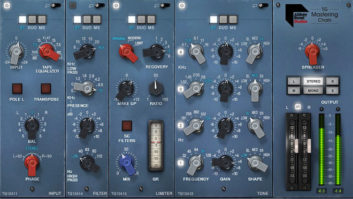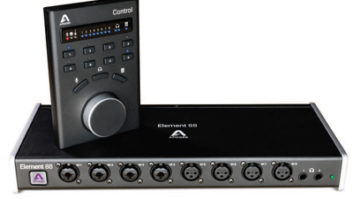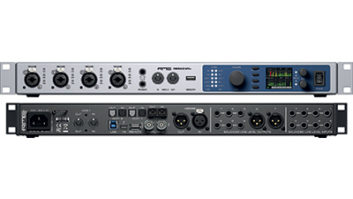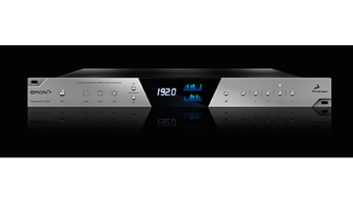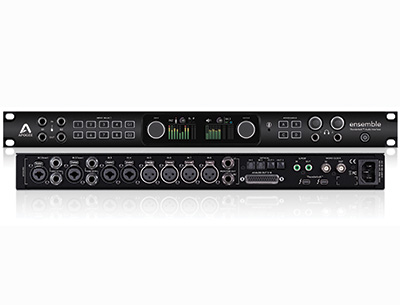
Last year I checked out Apogee’s Quartet, a small, sleek, USB desktop interface. The unit sounded great and could easily hold its own against any other product in its class. With so many terrific-sounding interfaces out there these days, that may not have been enough to set it apart. What really stood out in my memory, though, were two things:
First, Quartet connected to an iPad using a Lightning cable and worked seamlessly with audio apps like Garage Band. This shed light on an obvious relationship between Apogee and their California neighbors at Apple. The second thing was the intelligent design of the software control panel. Everything was presented in a way that was clear and concise, while simultaneously being packed with features. The graphics were clean and simplistic, allowing the window to be easily scaled and take up little space on the screen.
When I fired up the Ensemble for the first time, it became very clear that Apogee had once again played to those two strengths. The Ensemble exhibits an unparalleled harmony with Apple technology while serving up software that is an extension of your own thought process. Along the way, it also happens to sound really great.
Hardware Features
The Ensemble Thunderbolt claims to be the first professional interface to take advantage of the newer 20 Gb/s Thunderbolt 2 protocol. This combined with an all-new driver has dropped round-trip latency to a mere 1.1 ms in the company’s bench tests. This is allegedly the fastest of any “all-in-one” interface.
The Thunderbolt 2 protocol uses the exact same cables and connectors as Thunderbolt 1. This is the same form factor as Apple’s Mini DisplayPort. While no Thunderbolt cable is included with the Ensemble, there are two connectors on the unit, allowing daisy chaining with hard drives, peripherals or displays.
The back panel of the Ensemble also provides a wealth of audio I/O. The interface is billed as 30-in/34-out, so how do we get there? The easy ones are the XLR inputs on the back, four of which are XLR/TRS combo jacks, the other four are standard XLR jacks. Each of the eight can be used to feed a mic preamp or line level circuit, with the combo jacks also designed to accept high-impedance instrument signals. The separate mic, line and instrument circuits are relay switched for the cleanest sound. The first two inputs also have dedicated, balanced inserts using separate ¼-inch TRS connections for send and return.
One or two XLR jacks on the front are always a welcome convenience, but none are found on the face of the Ensemble. Instead, it has an additional pair of instrument inputs bringing the input total to ten. Each one of these inputs is paired with a high-impedance ¼-inch output. This allows a guitar to be recorded, but also monitored, through an amp with zero latency. These output jacks can also be repurposed as dedicated high-impedance re-amp outputs, so previously recorded instruments can be re-recorded through outboard stomp boxes or amplifiers. Likewise, software effects pedals can process a live guitar performance, but then be fed to an outboard amp.
There are also two Toslink optical inputs to accept up to 16 channels of ADAT optical with SMUX available, and a single RCA-type coax S/PDIF input, bringing the digital input total to 18. Ten analog inputs plus 18 digital is only twenty-eight, so the last “two” inputs are reserved for general use. This is handy as a talkback input and can be routed to any number of outputs. While it can also be routed for recording, it is designed with the same type of crushing limiter that you find in a lot of talkback inputs, and isn’t nearly as versatile as those found in a Duet or ONE.
On the output side, you’ll find the same complement of digital connections, with two TOSLINK connectors and a S/PDIF co-ax. Eight analog outputs are presented on a DB-25 connector, while an additional stereo pair is configured as the default monitor output. The two instrument thru/sends and two discrete headphone jacks add six more “outputs” to a total that could technically be considered 34.
Taking Control
The front panel of Ensemble shows a nice balance of economy without being so minimal that it is cumbersome. In the center are two vivid OLED displays, one for input metering and control, and the other displaying output levels. Each is paired with a rotary encoder/button. A set of rubber soft keys appropriate the input control to each of the input choices. Pressing and holding each soft key gives you access to a full menu of options for phantom powering, HPF, Soft Limit, etc. While none of the inputs have pads, it seems that the input stages were set up with enough headroom that a pad would not be necessary. While I never found that I needed one, inline attenuators could be added to the input cable in a pinch.
Deeper routing functions to take advantage of low-latency monitoring are available through the same Maestro software that controls the ONE Duet, and Quartet. The Ensemble requires the new Maestro 2, which only runs on OS X Version 10.9.3 or higher. Keeping in mind that Pro Tools 10 is not supported past OS X 10.8, an upgrade to Pro Tools 11 is required to ensure maximum compatibility. That said, I ran the Ensemble with Pro Tools 10.3.9 on OS X 10.9.5 and had no issues.
Maestro 2 has the same simplistic, no-flair appearance as the previous version. The window can be scaled, meaning it can hide in a corner of the screen and still be accessible. The operation is extremely intuitive, as functions are neatly organized in a variety of logical tabs. It seems like some of these software mixers try to put too much on one screen and offer more functions than anyone will ever use. The Ensemble keeps it simple. Aside from pages dedicated to settings for inputs, outputs, sample rates and clocking, and other obvious functions, there is a routing matrix much like the Pro Tools I/O Settings grid that can map any software output to any physical output. There are also four software mixers that can combine a single software return with any number of low-latency inputs, and can be routed to any output. It seems that four internal mixers should be plenty for any session, which is appropriate for the Ensemble.
In Use
At first, I just wanted to get comfortable using Pro Tools and Maestro 2. I had to record some voiceovers, and I wanted to assess the latency and how convenient building headphone mixes for the talent would be. Keep in mind that setting the Hardware Buffer in Pro Tools plays a role in total round-trip latency, but buffering delays in different data buses like USB, FireWire, PCIe and Thunderbolt all contribute, as well. On top of that, pulling data from RAM, to the CPU, and down through a data bus can create a delay as well. The Ensemble’s use of Direct Memory Access, which pulls data right from RAM to the Thunderbolt port without processing it through the CPU, takes a workload off of the processor and minimizes delay. I could overdub onto a busy session that required a 256-sample buffer size for smooth playback without any noticeable delay. By 512 samples, the delay became a little uncomfortable, though that is usually the case even when using PCIe interfaces.
When recording speech with a Blue Bottle Rocket mic, I was very impressed by the sound quality. In my memory, Apogee mic preamps and converters have always been just a little brighter than other manufacturer’s. The Ensemble’s front end seemed less colored and truer to the acoustic sound. That said, there was plenty of detail and clarity, and speech was able to easily cut through a music bed. The whole frequency response seemed really balanced, and the bottom end was full and tight. This neutral character made these preamps a very nice choice for nearly any source.
Perhaps the most striking part of the overall sound was that the noise floor was essentially non-existent. It was one of the quietest preamp/AD converter combos I’ve ever heard. Even when I gained it up to a ridiculous level, I never heard a hiss or hum that could be attributed to the circuit. I was also impressed with the amount of gain available. When recording quieter sources like ukulele or even cloth Foley, I could set a hot level and still have gain to spare. It seems impossible that a pre can have so much range without any noticeable noise, but the Apogee engineers really pulled it off.
If you have been waiting to upgrade to a new Mac Pro until the existence of an appropriate Thunderbolt interface, the wait is over. If you are looking to add more, channels to your MacBook-based setup, this is the perfect way to do it, as well. With plenty of I/O for project studios right out of the box, and the expansion potential provided by digital I/O, this is the perfect centerpiece to the modern studio. It can serve as a monitor controller for multiple speaker pairs, or be configured for surround sound. Best of all, the pre’s and converters are top-notch and will not disappoint. If you’re in the market for a fully featured multichannel interface, this should be high on your list of choices. n
Brandon T. Hickey is an audio pro and rabid Blackhawks fan.
Try This
Try using the Ensemble with Logic Pro X. The instrument inputs sound great feeding the software pedal board and amplifiers, and plus, control of the inputs has been integrated into the software. Adjusting preamp or instrument gain, applying phantom power, engaging the HPF or changing the input sensitivity of line inputs can all be accomplished directly from the track in the software. That way your eyes can glance back and forth between meters and the control without leaving the screen.
Product Summary
COMPANY: Apogee Electronics
PRODUCT: Ensemble Thunderbolt
WEBSITE:www.apogeedigital.com
PRICE: $2,595 (with Waves Gold Bundle included)
PROS: Plenty of I/O. Great Thunderbolt integration.
CONS: Requires newer Mac and OS X 10.9.3 or higher.

